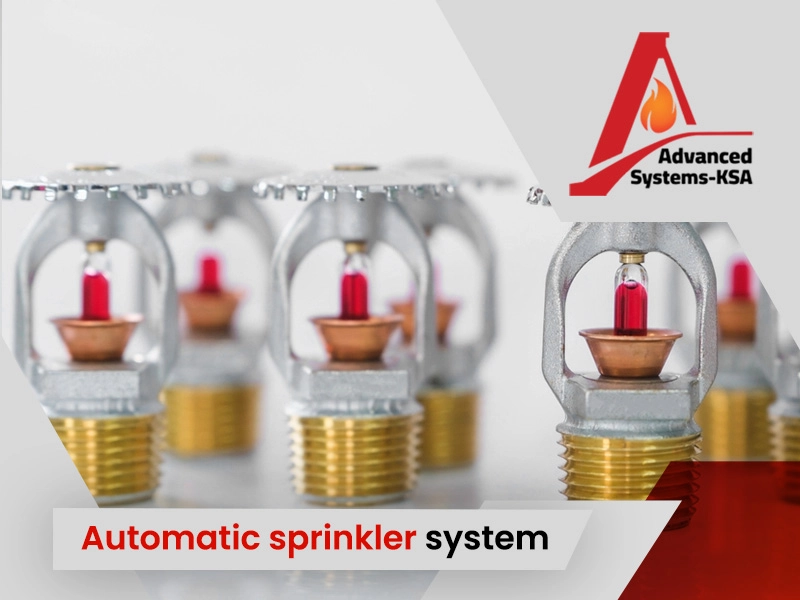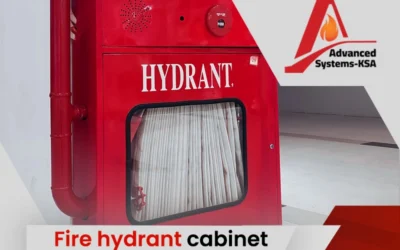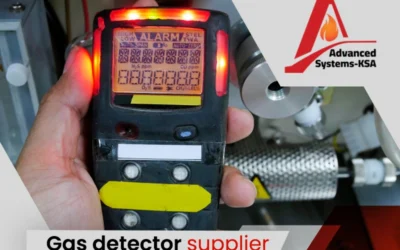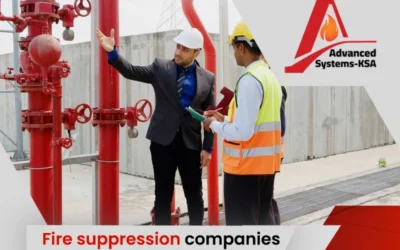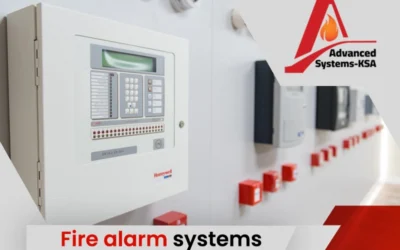A sprinkler system is a network of pipes, valves, and sprinkler heads designed to distribute water over a specified area. It can be divided into two types: manual or automatic sprinkler systems. Automatic fire sprinkler systems are designed to detect and extinguish fires very quickly to minimise damage and save lives.
This article highlights how automatic fire sprinkler systems work and how professional suppliers install them as “Advanced Systems.”.
Automatic Fire Sprinkler Systems Mechanism
When a fire starts, the automatic sprinkler system starts automatically pumping a massive amount of water over the fire to extinguish it quickly and prevent more damage. The following is an overview of how these systems work:
Read More About: Firefighting Company in Saudi Arabia
1: Detection and Activation
An automatic sprinkler system has heat-sensitive elements such as fusible links or glass bulbs filled with heat-sensitive liquid. When the temperature in the affected area rises, the elements are activated and trigger the releasing mechanism of the sprinkler head.
2: Water Releasing
There should be several sprinkler heads distributed in the facility to ensure safety. Each sprinkler head is activated individually and then releases water only to the affected area. Several heads may be activated automatically when the fire occurs on a large scale.
3: Distribution
Water flows through the system pipes to the activated sprinkler head. Water is then dispersed from small openings or nozzles in the head.
4: Fire Control
This system aims to control the fire by releasing the water at the base of the fire, helping to extinguish it or control its spread until firefighters arrive.
5: Work Harmoniously With Alarm
In many firefighting systems, the activation of a sprinkler head also triggers an alarm system to alert occupants and initiate an emergency response to the fire.
Automatic Sprinkler System Components
Any automatic sprinkler system consists of the following components that work together to detect and suppress fires:
The Water Supply
Water supply is considered the core of the system for extinguishing fires. A municipal water supply or a water tank can provide it. There must be sufficient pressure and flow rate to meet the system’s requirements.
Sprinkler Heads
They are the visible part of the system and are responsible for dispensing water when a fire is detected. They are distributed within the facility and are activated when exposed to a certain level of heat. There are different types of sprinkler heads:
- Pendant heads hang from the ceiling, and they are the most common type.
- Upright heads that are mounted vertically.
- Sidewall heads are for areas where ceiling-mounted sprinklers are not suitable.
Pipe Network
Pipes distribute water from the water supply to the sprinkler heads to be released. They come in different sizes and types. They can be made of plastic, steel, or copper. They are also installed on the property according to specific calculations made by specialists to ensure adequate water flow to each sprinkler head.
Valves
The valves control the flow of water within the system. The main control valve is located near the water supply connection, and it allows manual shut-off of the water supply. There are other valves named zone control valves that are installed to divide the system into zones, allowing for localised control and maintenance without disrupting the entire system’s operation.
Alarms
Automatic sprinkler systems have alarm devices to alert occupants and responsible people to a fire event. The alarms can be audible or visual indicators. These devices are triggered when the sprinkler heads activate.
Read About: Fire Alarm Control Panel
Control System
This system manages the operation and monitoring of the sprinkler system. It includes a control panel that receives signals from various sensors and activates the appropriate sprinkler heads.
Modern systems incorporate advanced features such as remote monitoring, integration with building management systems, and connectivity for real-time notifications.
Other Support Equipment
There are other equipment and tools that may be required to support the operation of this system, and they include:
- Water pumps to boost water pressure.
- Backflow prevention devices to ensure the integrity of the water supply
Automatic sprinkler system installation
Automatic sprinkler system installation requires careful planning, adherence to building codes and regulations, and attention to detail. Advanced Systems’ experts consider the following steps in the installation process:
- Design and planning by assessing the building’s layout, identifying fire hazards, performing hydraulic calculations, and developing a comprehensive design plan for the sprinkler system.
- Determining and connecting the water supply for the sprinkler system. Then, pipes will be installed to distribute water throughout the premises. The material layout and the size of the pipes are carefully chosen according to hydraulic calculations to ensure adequate water flow and pressure for all sprinkler heads.
- Installing sprinkler heads throughout the building based on the design plan. They are positioned in planned locations to ensure optimal coverage. Their types are chosen depending on specific requirements for each area.
- Installing valves to isolate specific zones and control the water flow. Then, there is the control system, which includes control panels and alarm devices.
- Testing and commissioning once the installation is complete. This includes conducting flow tests, pressure tests, and functional tests of individual sprinkler heads and the entire system. Any issues or deficiencies are addressed and corrected during this phase.
Automatic fire sprinkler systems maintenance
Experts at Advanced Systems strongly recommend regular maintenance to ensure the optimal functioning of sprinkler systems. This should include:
- Testing and checking the system as per the manufacturer’s guidelines and applicable regulations.
- Replacing or repairing damaged system components such as sprinkler heads, valves, and control panels.
In conclusion, automatic fire sprinkler systems in firefighting systems are essential for quick action in case of fire accidents. Advanced Systems, with its expertise, emphasises the significance of regular maintenance to uphold optimal functionality. Contact us now and get a consultation.
Read Also:
Safety Companies In Saudi Arabia Types of Fire Hydrants The fire hose storage Box Fire Protection Systems Fire Hose Reel System Fire Hydrant Pump Prices Fire suppression companies Types of Fire Alarm Systems
Fire Hose Cabinet Price
